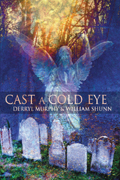 Cast a Cold Eye by Derryl Murphy & William Shunn
Cast a Cold Eye by Derryl Murphy & William Shunn
(PS Publishing, December 2009)
Reviewed by Steve Fahnestalk
Reviewing stuff by people you know can be hard, because you don’t want to hurt or offend your friends even unintentionally. But part of being a writer is learning how to take criticism; if your friends object to your honest opinion about their work, then it’s their problem, not yours. That said, I had no qualms about reviewing Derryl Murphy and William Shunn’s Cast a Cold Eye because although I don’t know William Shunn, I used to know Derryl Murphy quite well, and he’s a professional. He was a professional photographer at one time; and he’s striving to be a professional writer—and part of being a professional writer is growing a thick skin. Because, face it—even criticism from friends and relatives can get under your skin.
But I have no worries, because this novella, packaged in book form, is very good—and I would say that even if I knew neither of the authors. Set in 1920s Nebraska, in an area that was hit a couple of years earlier by the Spanish Flu epidemic that killed millions, it’s the story of young Luke Bryant, who was orphaned by that same flu. Luke is sometimes set upon by bullies on his way home from school, but he hates to cut through the graveyard to escape, because he has a problem—the stone angels on the graves open their eyes and look at him. Which creeps him out, and scares him—what if they decide to do more? And why are all these statues picking on him?
He has another problem—his aunt and uncle, who took him in when his parents died, have no familial feeling for him at all; they see him as a cheap source of labor. And they begrudge him his room and board. All in all, Luke’s life is not a happy one. And on one particular afternoon, while being chased by those bullies, he sees a strange vehicle parked by the graveyard—a rainbow-colored truck proclaiming its owner does “spirit photography.” Later, he finds that his uncle has hired him out to Annabelle Tupper, the truck’s owner, as her assistant.
Luke reluctantly goes to work for Annabelle, even though he is sure she is a fraud, preying on his friends and neighbors; he’s just a kid, after all, and must do what his guardian tells him. She’s a weird lady, with one black eye—she had an accident, long ago, with chemicals used in “wet plate” photography—and Luke is afraid to work for her, given his experiences in the graveyard. What Luke and Annabelle find together is that if there are spirits, they may be held here by us: captured against their wills to feed the grief and longing of the survivors.
The story is well told, with a strong narrative thrust—and the characters are believable as is the 1920s midwest setting. In fact, as a dual American-Canadian citizen, I find it impressive that Derryl, who’s Canadian, was able to convey such a great sense of time and place given that the time is nearly a century ago and the setting is half a continent away from Saskatoon, where he lives. Maybe William Shunn had a lot to do with that, but maybe rural is rural—Saskatchewan and Nebraska share conservative views, have hardworking farmers (the familiar “salt of the earth” types) and so on. Certainly there is little visible difference between some Canadian Prairie towns I’ve driven through and some Kansas/Nebraska towns I’ve driven through.
The characters, as I say, are well delineated—one can empathize with Luke’s loss and his fears of being bullied—as one can with Annabelle’s own loss (her dead husband, who taught her everything she knows about photography); perhaps a little less delineated is the “happy ending” wrapup to the story—but this is, after all, a novella, and the reader can definitely fill in the blanks with what shorthand ending’s been given. As to the action, there is a certain amount of necessary detail here about wet- and dry-plate photography (which comes from Derryl’s background, no doubt)—which evokes a sense of nostalgia in the reader, as photography moves inevitably and firmly into the digital era and film has almost disappeared for casual photography.
I recommend this book with only two tiny (and they are very small) reservations: one is the aforementioned happy ending—maybe it’s too convenient, but it does grow out of the information given the reader. And maybe a happy ending vitiates, or weakens the impact of the story—some people firmly believe that, although M.R. James, master of the English ghost story, took great pains to let the reader down gently at the end of every horrific tale. So Murphy and Shunn are definitely following in the footsteps of tradition. The other reservation is generic—the authors really need to learn the difference between “lie” and “lay”! Maybe it’s just me, but I feel writers have a duty to uphold the English language.